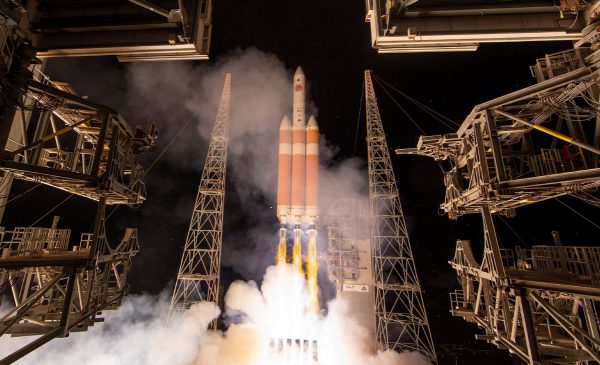
TAMPA-NASA on Sunday blasted off a $1.5 billion spacecraft toward the sun on a historic mission to protect the Earth by unveiling the mysteries of dangerous solar storms.
“Three, two, one, and liftoff!” said a NASA commentator as the Parker Solar Probe lit up the dark night sky aboard a Delta IV-Heavy rocket from Cape Canaveral, Florida at 3:31 am local time.
The Parker Solar Probe will fly straight through the wispy edges of the corona, or outer solar atmosphere, that was visible during last August’s total solar eclipse. It eventually will get within 6 million kilometers of the sun’s surface, staying comfortably cool despite the extreme heat and radiation, and allowing scientists to vicariously explore the sun in a way never before possible.
Protected by a revolutionary new carbon heat shield and other high-tech wonders, the spacecraft will zip past Venus in October. That will set up the first solar encounter in November. Altogether, the Parker probe will make 24 close approaches to the sun on the seven-year undertaking.
NASA has billed the mission as the first spacecraft to “touch the sun”.
The car-sized probe is designed to give scientists a better understanding of solar wind and geomagnetic storms that risk wreaking chaos on Earth by knocking out the power grid.
These solar outbursts are poorly understood, but pack the potential to wipe out power to millions of people.
“The Parker Solar Probe will help us do a much better job of predicting when a disturbance in the solar wind could hit Earth,” said Justin Kasper, a project scientist and professor at the University of Michigan.
Knowing more about the solar wind and space storms will also help protect future space explorers as they journey toward the Moon or Mars.
91-year-old namesake
The spacecraft is the only NASA probe in history to be named after a living person-in this case, 91-year-old solar physicist Eugene Parker, who first described the solar wind in 1958.
Parker said last week that he was “impressed” by the Parker Solar Probe, calling it “a very complex machine”.
“I really have to turn from biting my nails in getting it launched, to thinking about all the interesting things which I don’t know yet and which will be made clear, I assume, over the next five or six or seven years,” Parker said on NASA TV.
NASA chief of the science mission directorate, Thomas Zurbuchen, said on Saturday that Parker is an “incredible hero of our scientific community”, and called the probe one of NASA most “strategically important” missions.
Scientists have wanted to build a spacecraft like this for more than 60 years, but only in recent years did the heat shield technology advance enough to be capable of protecting sensitive instruments.
Tools on board will measure high-energy particles associated with flares and coronal mass ejections, as well as the changing magnetic field around the Sun.
When it nears the sun, the probe will travel rapidly enough to go from New York to Tokyo in one minute, making it the fastest human-made object.


